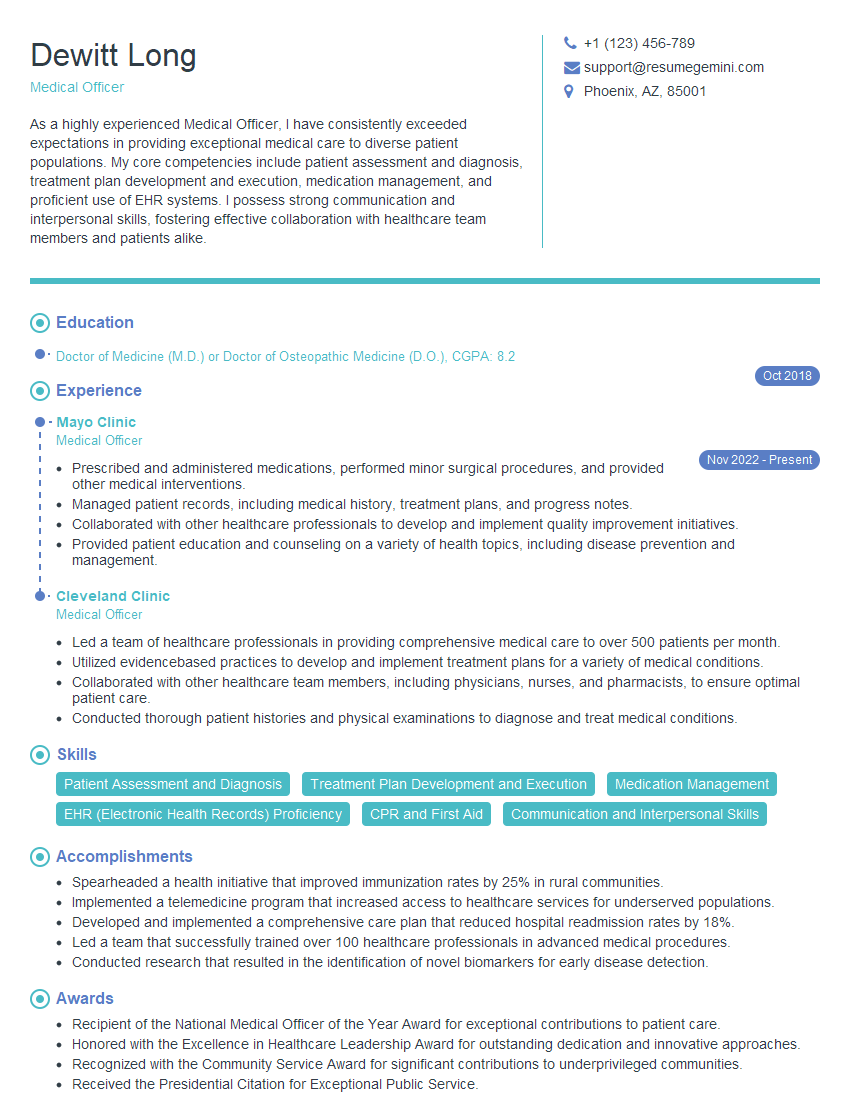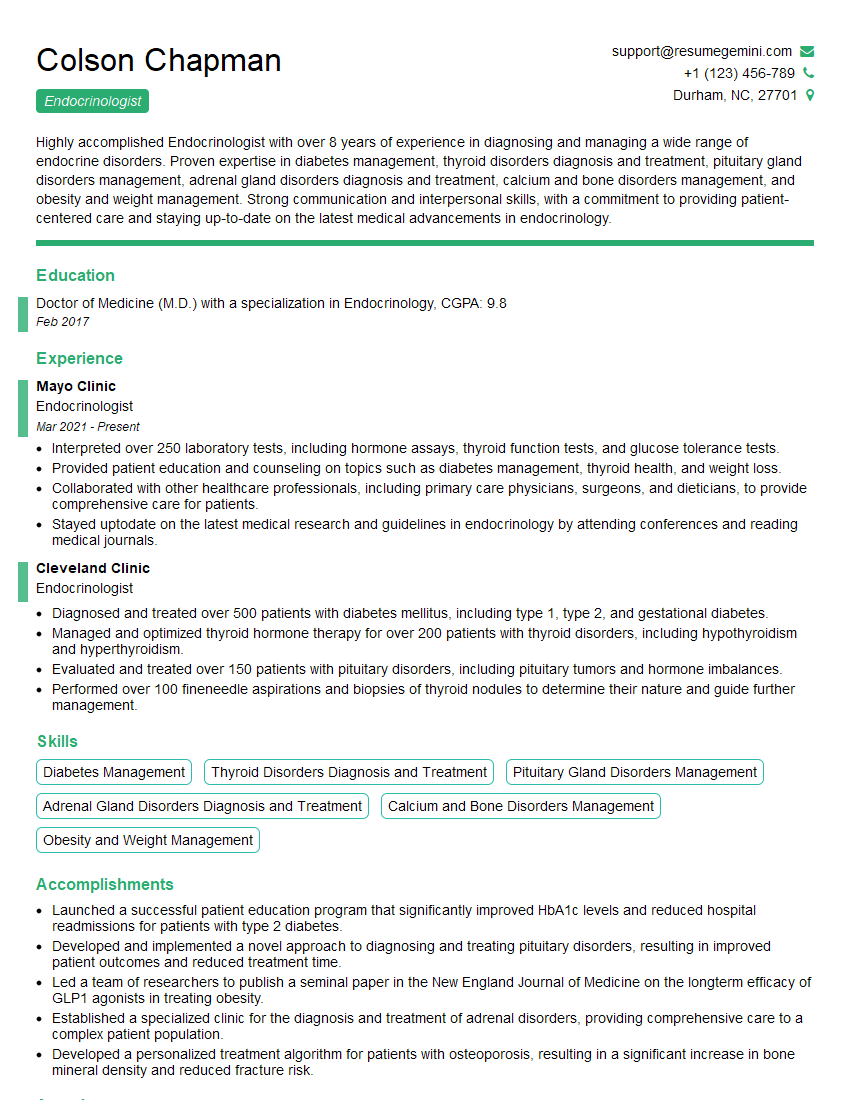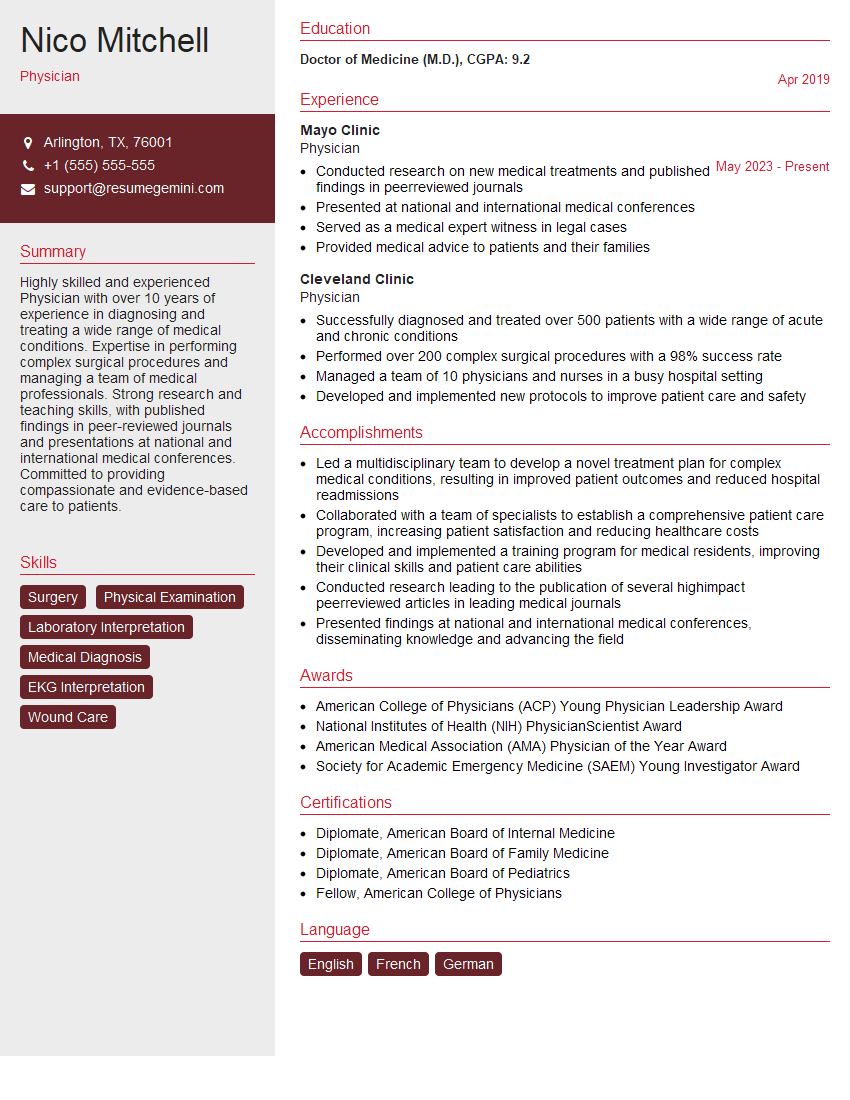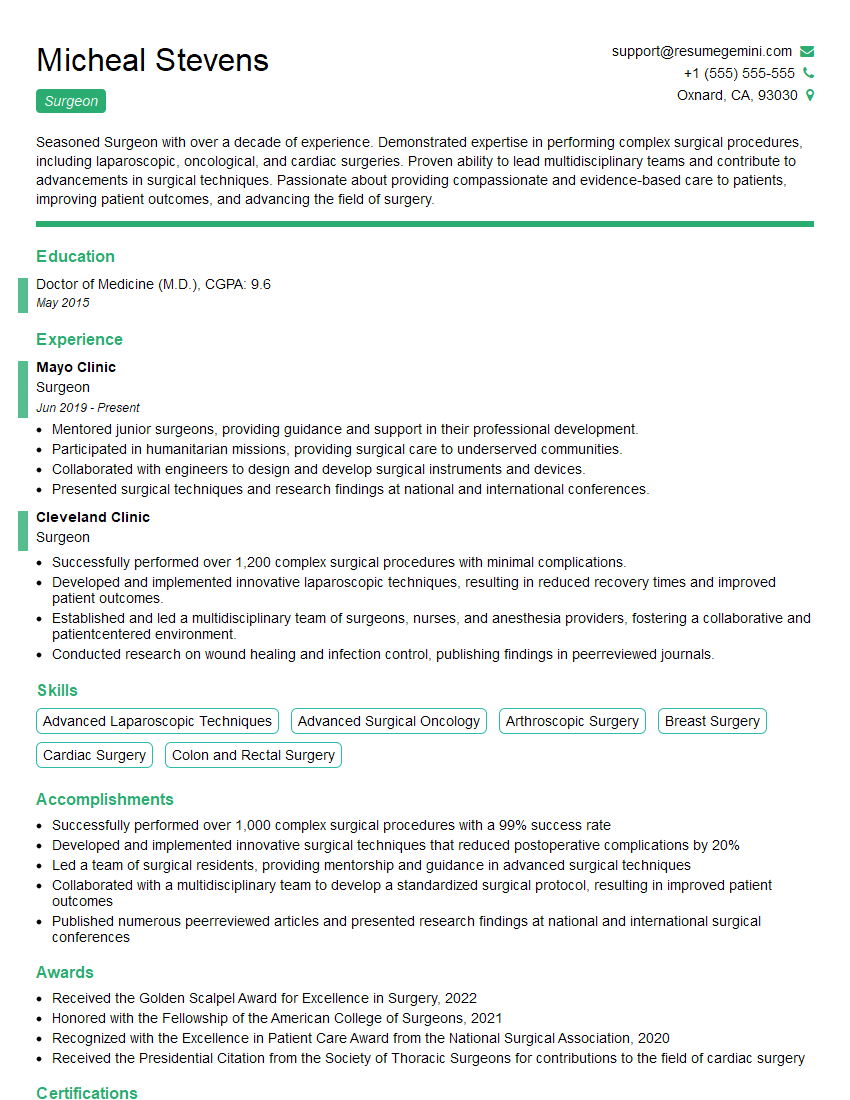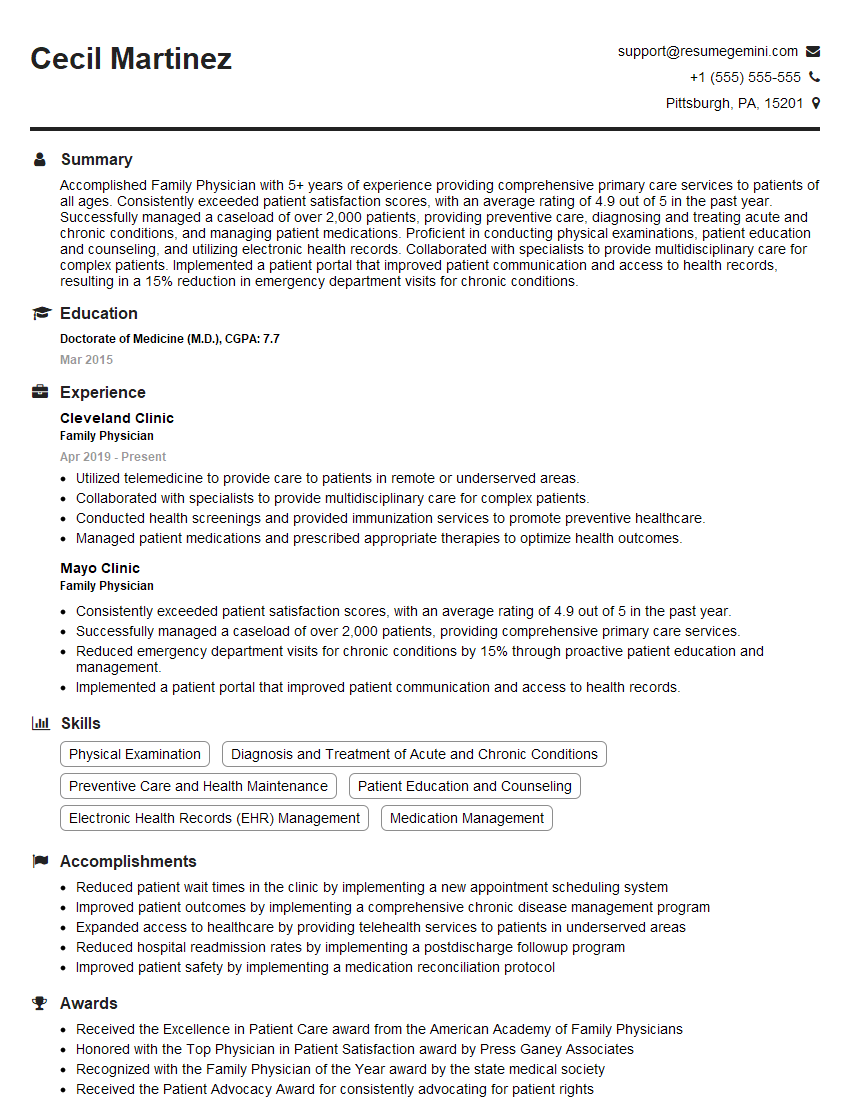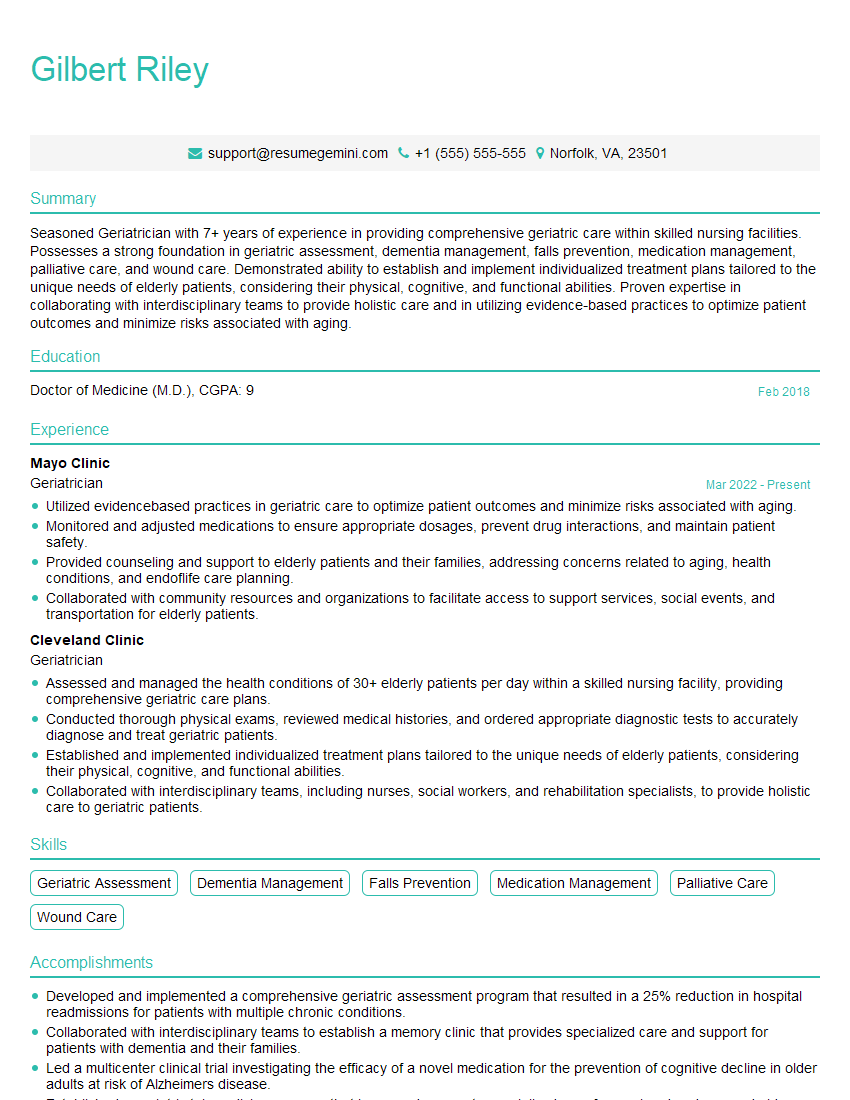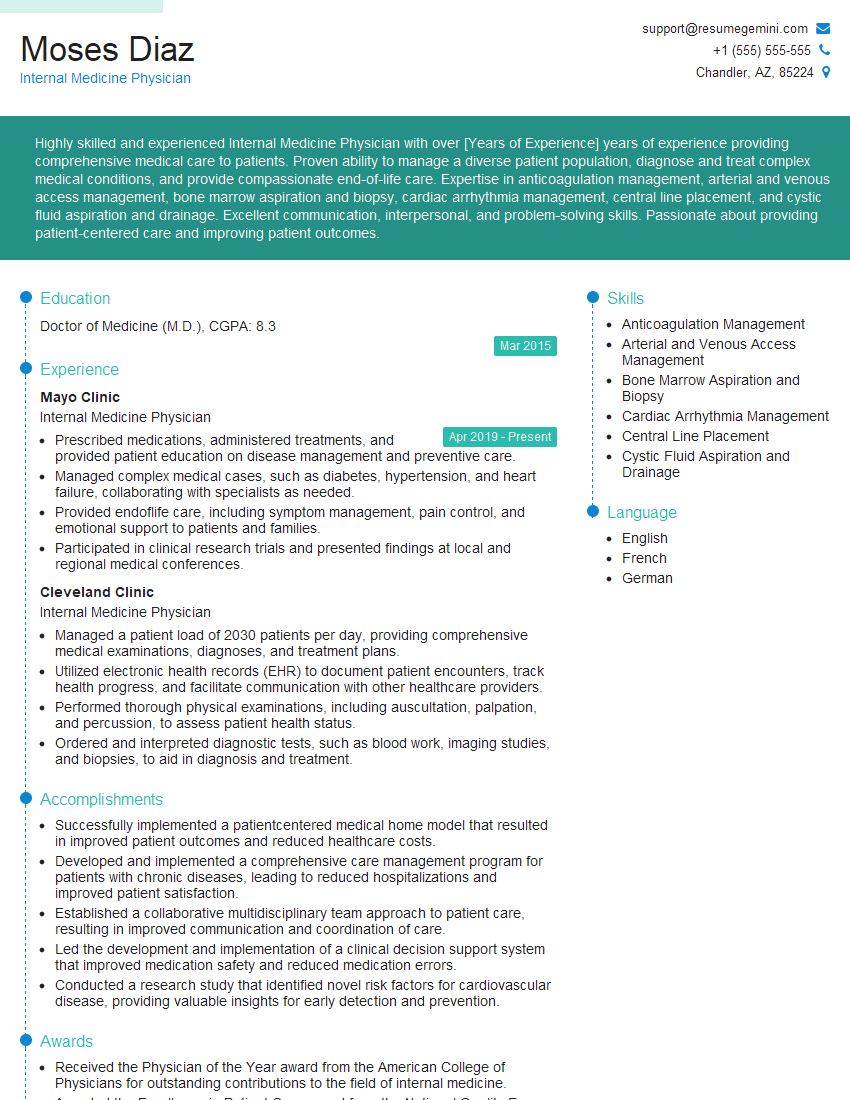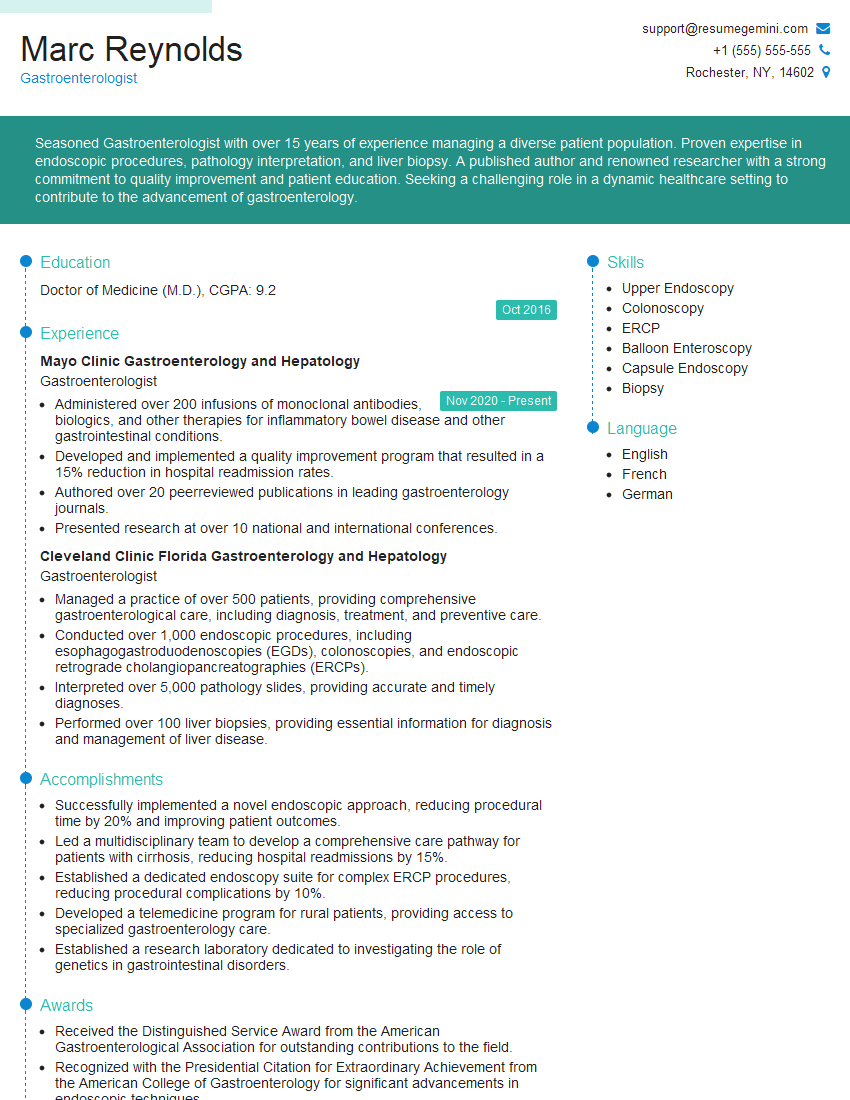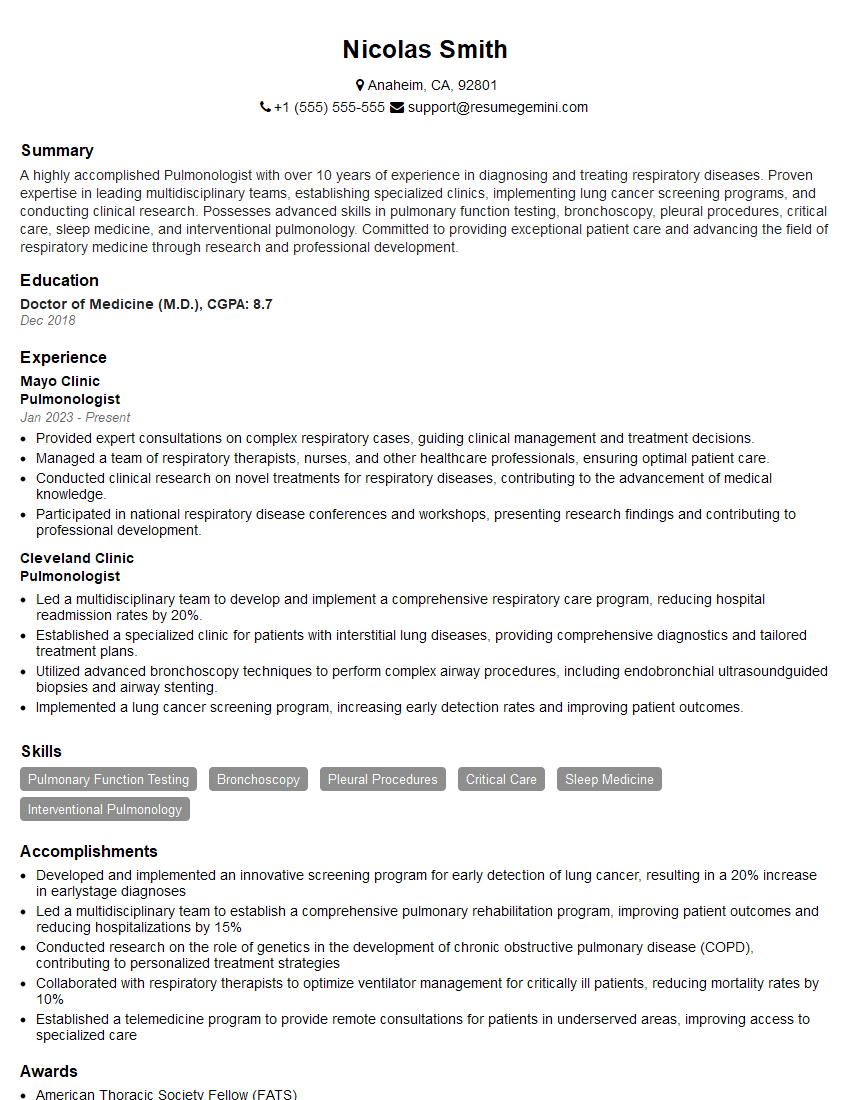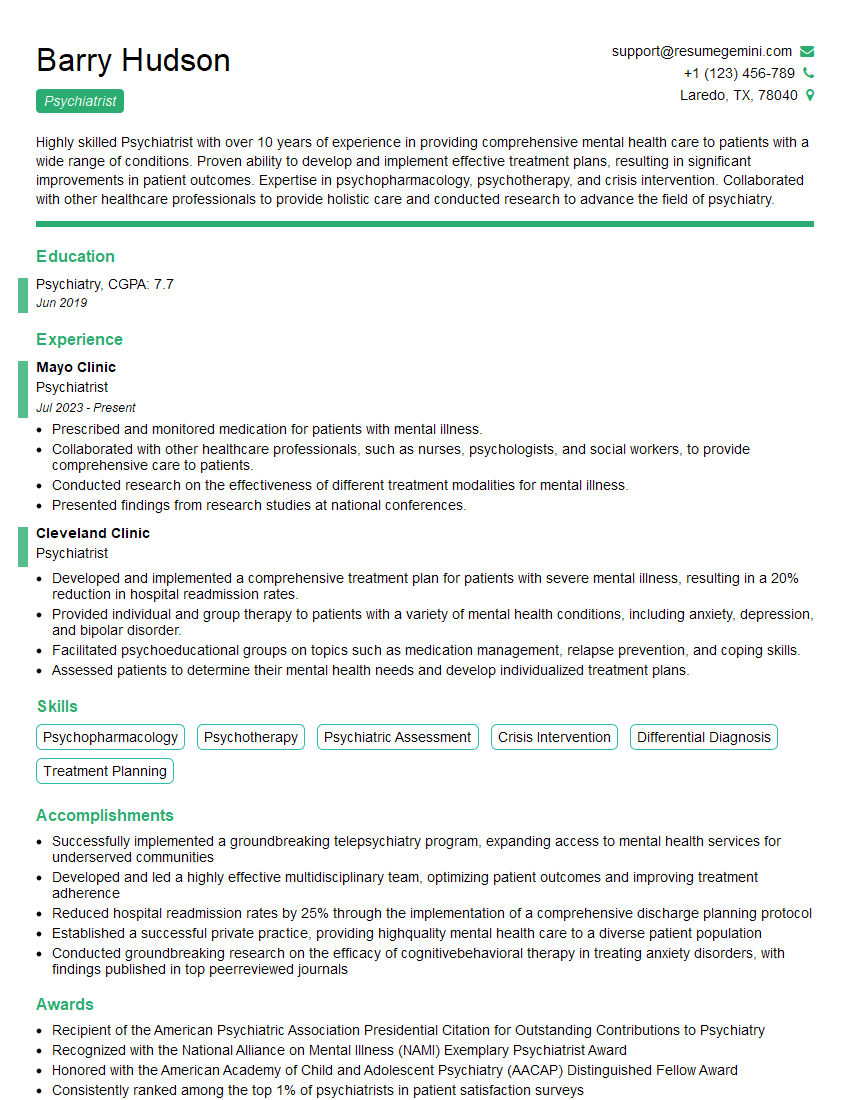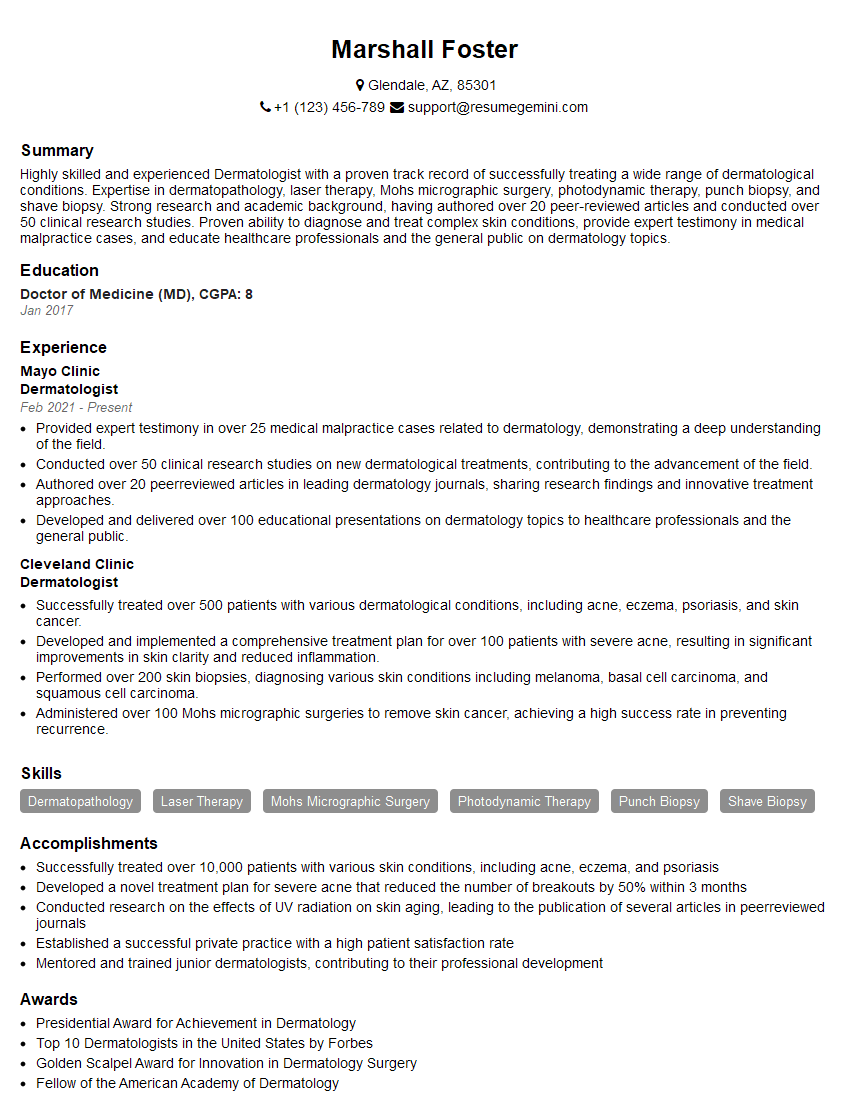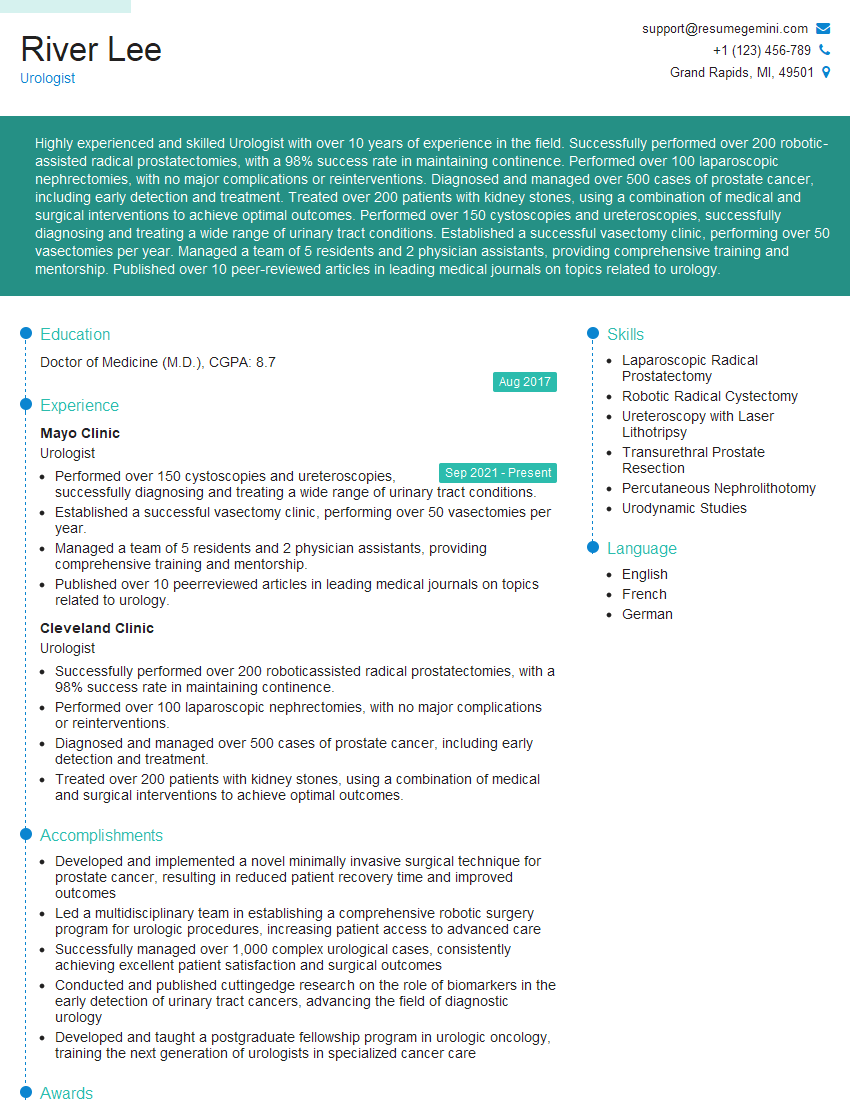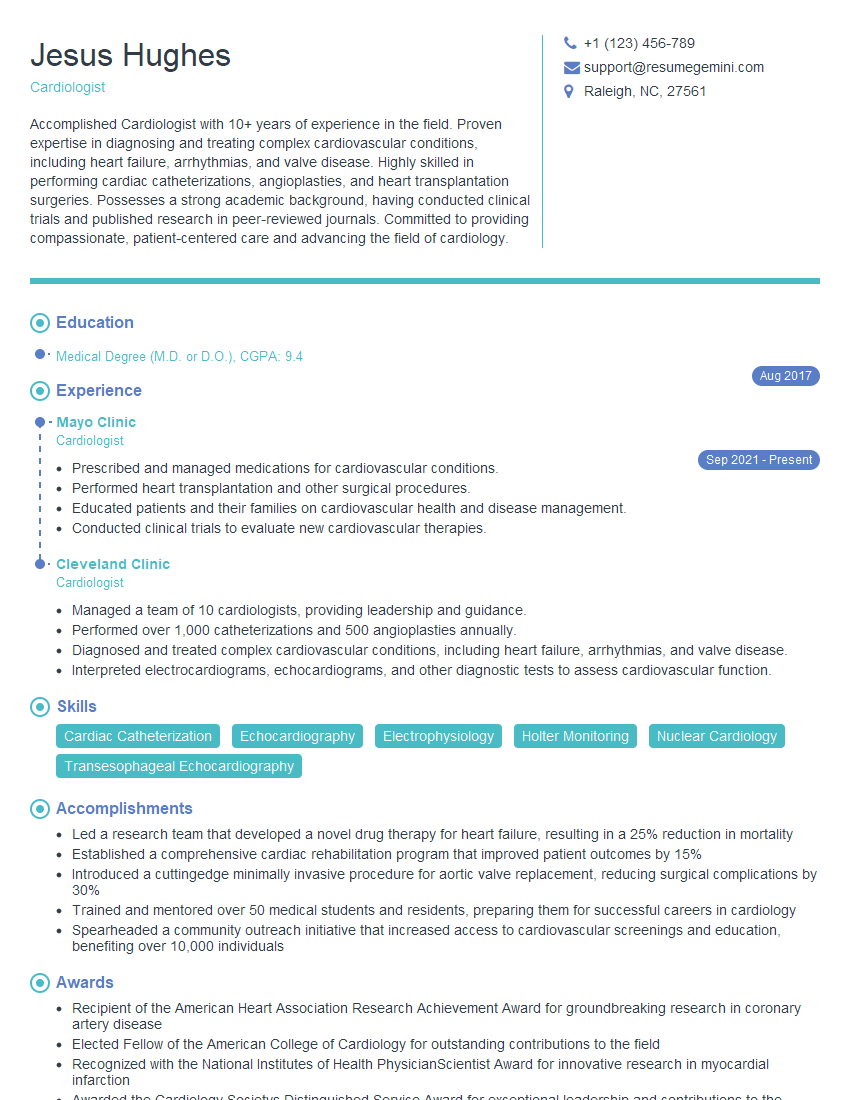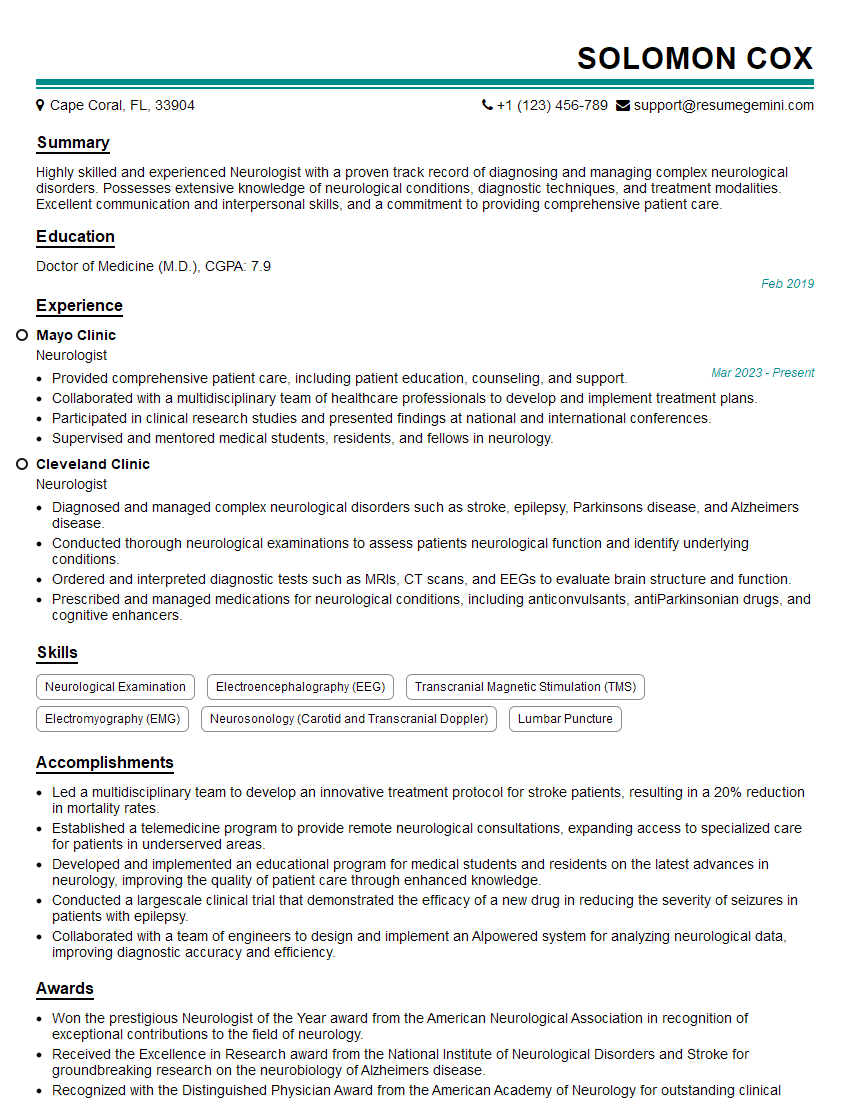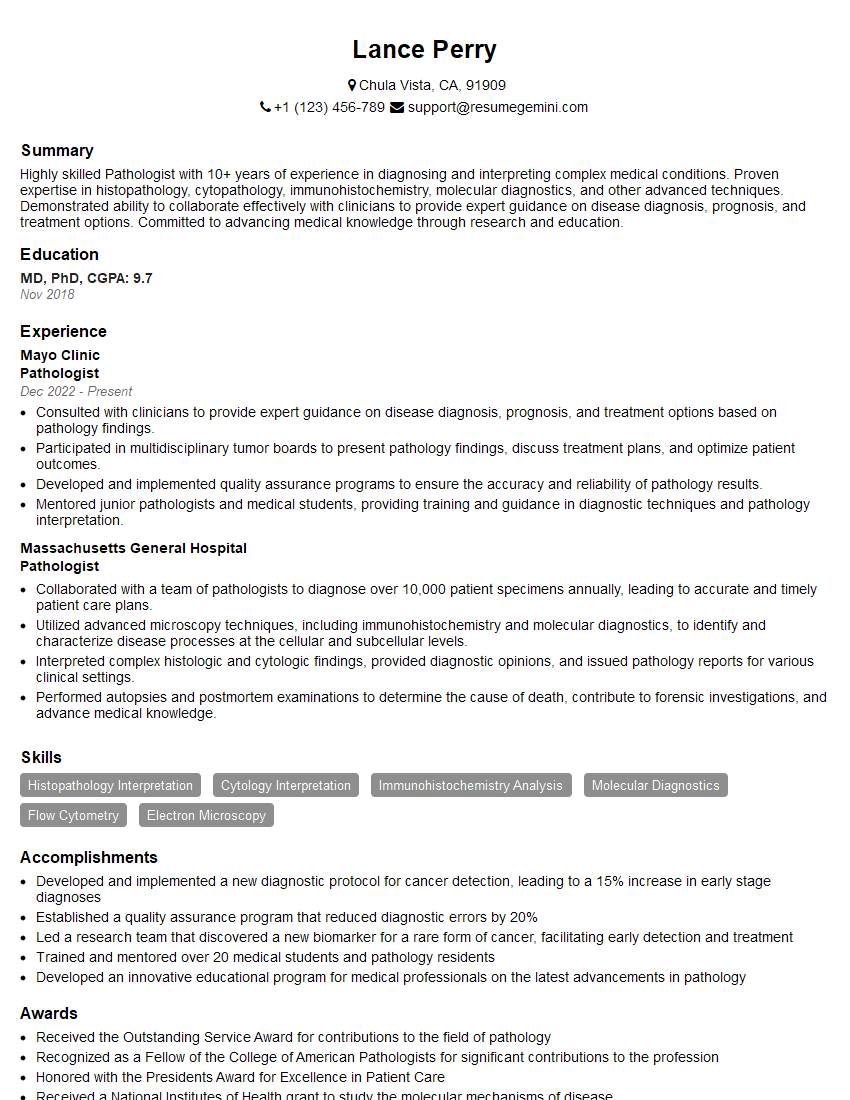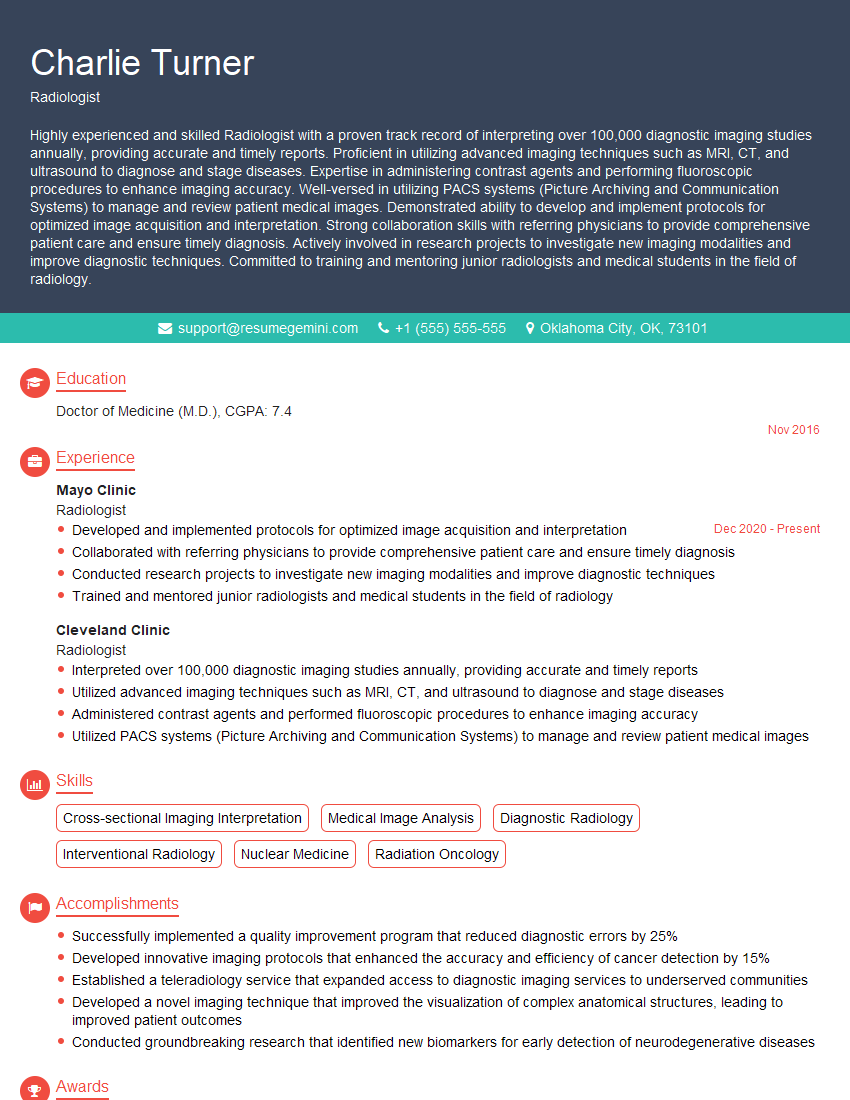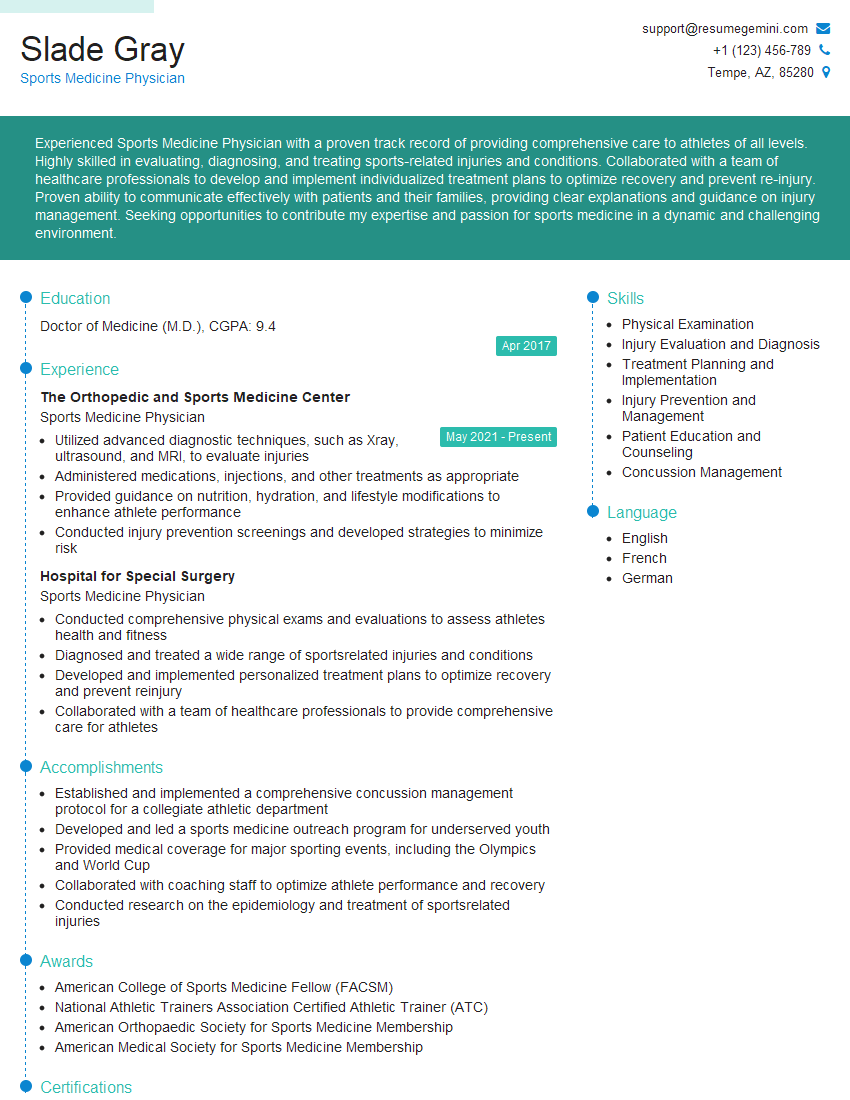Interviews are more than just a Q&A session—they’re a chance to prove your worth. This blog dives into essential Medical Examination interview questions and expert tips to help you align your answers with what hiring managers are looking for. Start preparing to shine!
Questions Asked in Medical Examination Interview
Q 1. Describe your experience performing a comprehensive physical examination.
A comprehensive physical examination is a systematic process of assessing a patient’s overall health. It involves a head-to-toe evaluation, using observation, palpation (touch), percussion (tapping), and auscultation (listening) to gather data. My approach begins with a thorough review of the patient’s medical history and chief complaint. Then, I proceed with a structured examination, starting with general observation (vital signs, appearance), followed by examination of each body system: head and neck (examining eyes, ears, nose, throat, lymph nodes), cardiovascular (listening to heart sounds, checking pulses), respiratory (listening to lung sounds), abdomen (palpating for tenderness, masses), neurological (assessing reflexes, coordination, mental status), and musculoskeletal (checking range of motion, muscle strength).
For example, when assessing the cardiovascular system, I carefully listen to heart sounds using a stethoscope, noting any murmurs, gallops, or irregular rhythms. In examining the abdomen, I palpate gently, looking for signs of tenderness, distension, or masses. This systematic approach ensures that no area is overlooked.
Throughout the examination, I actively engage the patient in conversation to address concerns, clarify findings, and build rapport. A comprehensive physical examination is tailored to the individual’s presenting complaint and overall health status, adapting the depth and focus as needed.
Q 2. Explain the procedure for documenting findings from a medical examination.
Accurate and thorough documentation is paramount in medical examinations. I utilize a structured format, typically a pre-printed form or electronic health record (EHR) system, to ensure consistency and completeness. The documentation must be objective, using precise medical terminology and avoiding subjective opinions. It includes the date and time of the examination, patient demographics, chief complaint, pertinent medical history, and a detailed record of the findings from each body system examined.
For example, instead of writing ‘heart sounds abnormal,’ I would document: ‘Auscultation of the heart revealed a systolic murmur, grade 2/6, best heard at the apex, radiating to the axilla.’ This level of detail allows for clarity and facilitates communication among healthcare professionals. Normal findings should also be documented, to provide a complete picture. The use of standardized abbreviations and terminology helps maintain consistency and clarity in documentation.
Any abnormal findings are described comprehensively, including their location, size, character, and any associated symptoms. Finally, the documented findings guide the clinician’s assessment, diagnosis, and subsequent management plan for the patient. In the case of electronic health records, I always check and confirm to ensure the accurate recording of data and to promptly amend any inconsistencies.
Q 3. How do you ensure patient comfort and privacy during a medical examination?
Patient comfort and privacy are paramount. I ensure a professional and respectful atmosphere, explaining each step of the examination clearly and obtaining consent before proceeding. I use proper draping techniques to maintain patient modesty, and I always knock before entering the examination room. The examination should be conducted in a private setting to safeguard confidentiality.
For example, I’ll verbally explain what I’m going to do before each step of the exam, allowing the patient to ask questions and express any concerns. I will avoid abrupt movements and try to use a calm and gentle touch. I ensure all electronic records and documentation is password protected and stored according to all relevant data protection guidelines. Creating a trusting and empathetic environment puts the patient at ease and makes them more likely to cooperate with the examination. A comfortable environment contributes to accurate assessment.
Q 4. What are the key components of a neurological examination?
A neurological examination assesses the function of the nervous system. It involves several key components: mental status (level of consciousness, orientation, cognitive function), cranial nerves (testing each of the 12 cranial nerves), motor system (muscle strength, tone, coordination), sensory system (touch, pain, temperature, vibration), and reflexes (deep tendon reflexes, plantar reflexes).
For example, assessing mental status might include evaluating the patient’s level of alertness, orientation to person, place, and time, and their ability to perform simple cognitive tasks. Testing cranial nerves involves checking functions such as eye movement, facial sensation, hearing, and swallowing. Assessing the motor system involves evaluating muscle strength by asking the patient to resist pressure, observing gait, and checking for coordination using tests like finger-to-nose. Sensory examination involves testing the patient’s ability to feel different sensations in various parts of the body. Finally, reflex testing helps assess the integrity of the reflex arc. The combination of these elements provides a comprehensive assessment of neurological function.
Q 5. Describe your approach to examining a patient with suspected cardiac issues.
My approach to examining a patient with suspected cardiac issues begins with a detailed history, focusing on chest pain, shortness of breath, palpitations, and family history of cardiac disease. Then, I meticulously assess vital signs, particularly blood pressure, heart rate, and respiratory rate. Physical examination focuses on the cardiovascular system, including careful auscultation of the heart sounds for murmurs, gallops, or extra heart sounds, palpation of the carotid and peripheral pulses for rate, rhythm, and strength, and assessment of the jugular venous pressure.
I would also check for signs of peripheral edema (swelling in the extremities) and cyanosis (bluish discoloration of the skin). Depending on the suspected nature of the cardiac issue, additional examinations might be conducted, such as an electrocardiogram (ECG) or echocardiogram. Every step is carefully documented to support timely intervention and accurate diagnosis. The thoroughness of the exam, combined with a complete patient history, is essential to arrive at the most effective care plan.
Q 6. How do you assess respiratory function during a medical examination?
Assessing respiratory function involves observing respiratory rate, rhythm, and depth, noting the use of accessory muscles, and listening to breath sounds using a stethoscope. I would also assess for the presence of any cough, sputum production, or shortness of breath (dyspnea). Observation begins with inspection of the patient’s chest wall, looking for any asymmetry or abnormalities in respiratory movement. Palpation might be used to check for tactile fremitus (vibrations felt during speech). Auscultation involves systematically listening to breath sounds in different lung fields, noting any wheezes, crackles, or diminished breath sounds.
For example, I might document ‘Respiratory rate 22 breaths/minute, regular rhythm, clear breath sounds bilaterally’ indicating normal respiratory function. Conversely, a finding of ‘Respiratory rate 30 breaths/minute, labored respirations, wheezes heard throughout lung fields’ would indicate compromised respiratory function. The assessment of respiratory function requires a combination of visual observation and auscultation in order to provide a thorough diagnosis.
Q 7. Explain your method for documenting abnormal findings during a medical examination.
Abnormal findings are documented using precise and objective language, including specific details such as location, size, shape, color, and any associated symptoms. I use standardized medical terminology, avoiding vague descriptions. For example, instead of writing ‘rash,’ I might write ‘erythematous, maculopapular rash, 5cm in diameter, located on the left forearm, associated with pruritus.’ Accurate documentation enables other healthcare professionals to understand the findings and facilitates continuity of care.
I use clear and concise language, avoiding jargon whenever possible. I also include relevant details from the patient’s history and examination that help explain the abnormal finding. If applicable, photographs or sketches of the abnormal findings are also included to further illustrate what was found during the examination. Accurate and detailed documentation of abnormal findings is critical for providing optimal patient care.
Q 8. What are the legal and ethical considerations surrounding medical examinations?
Legal and ethical considerations in medical examinations are paramount, ensuring patient rights and well-being are prioritized. These considerations revolve around several key principles: Informed Consent: Patients must understand the purpose, procedures, and potential risks of the examination before agreeing. This includes explaining the benefits and alternatives, and addressing any questions or concerns. Failure to obtain proper informed consent can lead to legal repercussions. Confidentiality: Maintaining patient privacy is crucial. Information obtained during the examination must be protected and only shared with those directly involved in the patient’s care, unless legally mandated otherwise (e.g., mandated reporting of child abuse). Breaching confidentiality can lead to disciplinary actions and lawsuits. Professional Boundaries: Maintaining appropriate professional boundaries is essential. This involves avoiding inappropriate physical contact or behavior and ensuring the examination environment is respectful and safe. Any deviation from professional conduct can result in serious consequences. Capacity and Competence: The patient must possess the mental capacity to understand and consent to the examination. If capacity is questionable, alternative procedures might be necessary, such as obtaining consent from a legal guardian. Legal Mandates: Certain examinations may be legally mandated in specific circumstances, such as court-ordered evaluations or mandated reporting. Medical professionals must be aware of these legal requirements. Cultural Sensitivity: Respecting cultural differences and beliefs is vital. Cultural factors can influence attitudes towards physical examination and modesty. Sensitivity to these factors can improve the patient experience and ensure cooperation during the examination.
For example, a physician who performs a pelvic exam without obtaining proper informed consent from the patient could face a malpractice lawsuit. Similarly, a healthcare provider who shares a patient’s medical information without authorization could face disciplinary action from their licensing board.
Q 9. How do you handle a situation where a patient refuses a portion of the examination?
If a patient refuses a portion of an examination, the first step is to understand the reason for their refusal. Open and respectful communication is crucial. It’s vital to listen empathetically, addressing concerns and clarifying any misunderstandings about the procedure. Sometimes, fears or anxieties about pain or discomfort underlie the refusal. Explaining the rationale for the specific procedure, its benefits, and alternatives can help alleviate concerns. If the refusal is based on religious or cultural beliefs, accommodating those beliefs as much as possible should be attempted.
Documentation is crucial: The refusal should be carefully documented in the patient’s medical record, including the reason for refusal and any attempts made to address the patient’s concerns. While respecting patient autonomy, I would always explain the potential risks and benefits of proceeding with or refusing the examination, outlining how the incomplete exam might impact diagnosis and treatment. Ultimately, the patient’s decision should be respected, even if it means delaying or altering the diagnostic process. In rare instances, if the refusal could pose a significant risk to the patient’s health or the health of others, ethical consultation with colleagues or legal counsel might be necessary.
Q 10. Describe your experience with using various medical instruments during examinations.
My experience with medical instruments is extensive and encompasses a wide range of tools used in various examinations. This includes ophthalmoscopes for eye examinations, otoscopes for ear examinations, stethoscopes for listening to heart and lung sounds, reflex hammers for neurological examinations, and various instruments for performing physical assessments (e.g., measuring tape, calipers). I’m proficient in using specialized instruments like flexible endoscopes for upper and lower GI examinations, and have experience utilizing electrocardiography (ECG) machines for recording heart activity. I’m also comfortable with utilizing diagnostic imaging equipment, though interpretation is done by radiologists. Throughout my career, I’ve adhered strictly to sterile techniques and safety protocols when using any medical instrument. Regular training and competency assessments maintain my proficiency and adherence to best practices.
For example, when performing a neurological exam, the proper use of a reflex hammer involves a specific technique to elicit a response. Similarly, using an ophthalmoscope requires precision and a gentle touch to properly visualize the interior structures of the eye without causing discomfort to the patient. My expertise ensures safe and accurate application of all these instruments in different clinical contexts.
Q 11. Explain the difference between a subjective and objective finding in a medical examination.
In medical examinations, subjective and objective findings represent distinct aspects of a patient’s condition. Subjective findings are based on the patient’s reports and descriptions. These are things the patient tells you they are experiencing, such as pain, nausea, dizziness, or fatigue. They are not directly observable by the examiner. For example, a patient reporting ‘sharp chest pain’ is a subjective finding. Objective findings, conversely, are directly measurable or observable by the examiner during the physical examination. They are factual and quantifiable. Examples include vital signs (temperature, blood pressure, heart rate, respiratory rate), physical exam findings (e.g., skin rash, abnormal lung sounds, palpable lymph nodes), or lab test results. For example, a temperature of 102°F is an objective finding.
Differentiating between subjective and objective findings is critical for accurate diagnosis and treatment. Objective findings validate and contextualize subjective complaints, providing a more comprehensive picture of the patient’s health. Proper documentation includes clearly distinguishing between subjective and objective data to ensure clear and accurate medical records.
Q 12. How do you interpret and document vital signs during a medical examination?
Interpreting and documenting vital signs—temperature, pulse, respiration, and blood pressure (TPR and BP)—is fundamental to medical examination. These signs provide crucial insights into a patient’s physiological state. Temperature is measured using a thermometer (oral, rectal, axillary, tympanic) and reflects the body’s core temperature. Pulse rate (beats per minute) indicates the heart’s efficiency. It is measured by palpating a peripheral artery (e.g., radial artery at the wrist). Respiration rate (breaths per minute) assesses the respiratory system’s function. Blood pressure, measured using a sphygmomanometer, reflects the pressure exerted by blood against artery walls (systolic and diastolic pressures).
Accurate documentation is vital. I record the values obtained using standardized units (e.g., °C or °F for temperature, bpm for pulse and respiration, mmHg for blood pressure). I also note any abnormalities or deviations from normal ranges, along with the method of measurement and any relevant contextual information (e.g., patient’s position, activity level). For instance, an elevated temperature might be documented as ‘Temperature: 39°C (oral), patient reports chills.’ This detailed approach facilitates prompt identification of potential issues, ensuring timely and appropriate medical intervention.
Q 13. What are the common signs and symptoms of various medical conditions you have encountered?
My clinical experience encompasses a wide range of medical conditions, and I’ve observed diverse signs and symptoms. For instance, in respiratory illnesses, I’ve encountered patients presenting with cough, shortness of breath (dyspnea), chest pain, fever, and wheezing. Cardiovascular conditions might manifest as chest pain (angina), palpitations, shortness of breath, edema (swelling), and irregular heartbeat. Gastrointestinal issues can involve nausea, vomiting, abdominal pain, diarrhea, and constipation. Neurological conditions can include headaches, dizziness, numbness, weakness, and changes in cognitive function. Infectious diseases may present with fever, chills, body aches, rash, and lymphadenopathy (swollen lymph nodes). Finally, dermatological conditions might feature rashes, lesions, itching, and skin discoloration.
It is important to note that the presence of these signs and symptoms doesn’t automatically confirm a specific diagnosis. A thorough history-taking and comprehensive physical examination are necessary, often augmented with laboratory investigations and imaging studies, to reach a definitive diagnosis. For example, chest pain could stem from various causes (cardiac, musculoskeletal, gastrointestinal) making accurate diagnosis challenging. My experience lies in piecing together the puzzle presented by a patient’s symptoms and examination findings to arrive at the most probable diagnosis.
Q 14. How do you communicate examination findings to patients and other healthcare professionals?
Communicating examination findings effectively is crucial for patient care. When communicating with patients, I use clear, concise language, avoiding complex medical jargon. I explain the findings in a way that is easy to understand, ensuring the patient is actively involved in their care. I answer questions patiently and address any concerns they may have. This approach fosters trust and ensures the patient is fully informed about their health status and treatment options. Visual aids, such as diagrams or illustrations, might be used to enhance understanding.
Communication with other healthcare professionals requires a different approach. I employ precise and accurate medical terminology in my written and verbal reports. I detail my objective and subjective findings, outlining my reasoning and conclusions. I use structured reporting formats, often including specific templates, depending on the setting (e.g., hospital, clinic). This structured communication ensures clarity and avoids any misinterpretation. For example, I might summarize findings using a problem-oriented medical record (POMR) system, highlighting key findings, diagnoses, and treatment plans. Effective communication ensures seamless care coordination and continuity across the healthcare team.
Q 15. Describe your experience with performing examinations on patients with diverse backgrounds.
Throughout my career, I’ve had the privilege of examining patients from diverse cultural, socioeconomic, and linguistic backgrounds. Effective communication is paramount. This involves adapting my approach to consider individual needs and preferences. For instance, with a patient who speaks limited English, I would utilize a qualified interpreter, ensuring accurate information exchange. With patients from different cultural backgrounds, understanding non-verbal cues and being sensitive to cultural norms regarding touch and personal space are crucial. For example, some cultures may prefer less direct eye contact, and a thorough understanding of this prevents misinterpretations. I always strive to create a safe and comfortable environment where patients feel respected and understood, irrespective of their background, promoting a more effective examination.
In one instance, I examined a patient from a culture where discussing intimate details is considered taboo. By employing a sensitive and empathetic approach, and building trust through careful explanation and respect for their boundaries, I was able to obtain necessary information without causing discomfort or offense. This experience reinforced the importance of cultural competency in patient care.
Career Expert Tips:
- Ace those interviews! Prepare effectively by reviewing the Top 50 Most Common Interview Questions on ResumeGemini.
- Navigate your job search with confidence! Explore a wide range of Career Tips on ResumeGemini. Learn about common challenges and recommendations to overcome them.
- Craft the perfect resume! Master the Art of Resume Writing with ResumeGemini’s guide. Showcase your unique qualifications and achievements effectively.
- Don’t miss out on holiday savings! Build your dream resume with ResumeGemini’s ATS optimized templates.
Q 16. Explain your understanding of medical terminology and its application in documentation.
Medical terminology is the language of medicine, composed of precise terms that describe anatomical structures, physiological processes, diseases, and diagnostic procedures. Accurate use of medical terminology is essential for clear and unambiguous documentation, facilitating effective communication among healthcare professionals. Misunderstandings stemming from inaccurate terminology can have serious consequences. Consider the difference between ‘bradycardia’ (slow heart rate) and ‘tachycardia’ (fast heart rate). One wrong word could lead to a missed or delayed diagnosis.
In documentation, I consistently utilize standardized terminology, adhering to guidelines such as those provided by medical coding systems like ICD-10 and SNOMED CT. For example, when documenting a patient’s symptoms, instead of writing ‘pain in the chest,’ I’d use specific terms like ‘angina pectoris’ (if associated with heart disease) or ‘pleuritic chest pain’ (if associated with lung issues). This precision allows other clinicians to quickly grasp the clinical picture and facilitates appropriate decision-making. I also always cross-reference observations with objective findings during the examination. For instance, describing a patient’s gait as ‘antalgic’ (painful) provides a more concise and informative description than simply stating they have a ‘limping gait’.
Q 17. How do you prioritize findings during a complex medical examination?
Prioritizing findings during a complex examination involves a systematic approach that combines clinical judgment, knowledge of pathophysiology, and understanding of the patient’s history. I employ a hierarchical framework that prioritizes life-threatening conditions first. Using the ABCDE approach (Airway, Breathing, Circulation, Disability, Exposure) serves as a guide in emergent situations. In non-emergent scenarios, I prioritize findings based on their potential severity and impact on patient well-being. For instance, signs of acute stroke would take precedence over a minor skin lesion.
Furthermore, I consider the patient’s overall presentation, correlating findings across multiple systems. For example, an elderly patient presenting with altered mental status, accompanied by shortness of breath and hypotension, would necessitate a thorough assessment focused on cardiovascular and respiratory systems, with potential neurological implications. I then document the findings clearly and systematically, using a logical flow that allows others to easily follow my thought process. Using clear headings and subheadings helps in organizing and prioritizing information.
Q 18. What are the limitations of physical examination and when would you order further investigations?
Physical examination, while invaluable, has limitations. It’s subjective to some extent, influenced by the examiner’s skill and experience. It also can’t detect certain conditions, and often serves as a first step toward more specific investigations. For example, a physical exam might reveal signs of abdominal pain and tenderness, but it can’t confirm the underlying cause – appendicitis, bowel obstruction, or other conditions. Similarly, subtle neurological deficits might be missed without sophisticated testing.
I order further investigations, such as imaging (X-ray, CT scan, MRI), laboratory tests (blood tests, urine analysis), or specialized consultations, when the physical exam alone is insufficient for diagnosis and management. This is particularly important when the patient’s symptoms don’t match classic presentations, when findings are inconclusive, or when serious conditions are suspected. For example, a patient presenting with chest pain would likely require an ECG and cardiac enzyme tests to rule out myocardial infarction. Similarly, unexplained fever could necessitate blood cultures and imaging studies to rule out serious infections.
Q 19. Describe your experience with emergency medical examinations.
Emergency medical examinations require rapid assessment and prioritization of life-threatening conditions. I’m proficient in performing focused examinations, aiming to identify and address immediately life-threatening issues quickly and efficiently. This involves a rapid assessment of the patient’s ABCDEs (Airway, Breathing, Circulation, Disability, Exposure), followed by a focused physical exam tailored to the presenting complaint. For example, in a trauma patient, assessment of airway patency, breathing effectiveness, and circulatory stability is paramount.
Experience has taught me the importance of clear communication and teamwork during emergencies. This includes effectively communicating findings to other members of the healthcare team, ensuring that appropriate interventions are implemented swiftly and effectively. I have significant experience managing patients presenting with various emergent conditions, including cardiac arrest, severe trauma, and acute respiratory distress. In each instance, a methodical and rapid approach ensured the provision of optimal care. Efficient documentation of the emergency examination is also vital for continuity of care, medico-legal purposes, and future reference.
Q 20. How do you maintain accurate and complete medical records?
Maintaining accurate and complete medical records is crucial for ensuring patient safety, facilitating effective communication among healthcare providers, and meeting legal and regulatory requirements. I adhere to strict protocols for documentation, ensuring that all entries are legible, complete, timely, and objective. This involves using standardized terminology and avoiding subjective language or assumptions. I document all findings systematically and chronologically, including the patient’s history, physical exam findings, diagnostic results, treatment plans, and progress notes. For example, instead of saying ‘patient was anxious,’ I’d record objective findings such as ‘patient exhibiting tachycardia, diaphoresis, and elevated blood pressure.’
Furthermore, I ensure that all relevant information is readily available and accessible to authorized personnel. This includes utilizing electronic health record (EHR) systems effectively and adhering to institutional guidelines for data security and privacy. I take precautions to promptly correct errors without obscuring original documentation, using an addendum when appropriate. Continuous review and audit of my records ensure accuracy and completeness and helps prevent potential errors in future.
Q 21. How do you stay updated on the latest advancements in medical examination techniques?
Staying updated on advancements in medical examination techniques is an ongoing commitment. I actively participate in continuing medical education (CME) activities, attending conferences, workshops, and seminars to stay abreast of the latest research, guidelines, and best practices. This includes reviewing peer-reviewed medical journals, participating in professional organizations, and engaging with online resources. For instance, I regularly review publications from organizations like the American Medical Association and the American College of Physicians.
I also actively participate in case discussions and peer review within my professional network, learning from the experiences of colleagues. Furthermore, I integrate new techniques and technologies into my practice as appropriate, always prioritizing evidence-based practices. For example, I regularly update my knowledge on the use of point-of-care ultrasound and its applications in various clinical settings. Continuous learning enables me to provide high-quality patient care using the most effective and current approaches to medical examination.
Q 22. Describe a challenging medical examination you performed and how you overcame the challenges.
One of the most challenging examinations I performed involved a patient with severe anxiety and a history of trauma. She was incredibly apprehensive about the physical examination, making it difficult to obtain a thorough assessment.
To overcome this, I prioritized building rapport. I started by spending extra time explaining each step of the process in simple terms, ensuring she understood the purpose and rationale behind every action. I allowed her to control the pace, pausing frequently and giving her opportunities to ask questions or take breaks. I used a calm and reassuring tone, focusing on her comfort and respecting her boundaries. For instance, when examining her abdomen, I explained exactly what I would be doing and why, allowing her to place her hand on mine for added reassurance. This approach, focused on empathy and patient-centered care, helped to create a safe and trusting environment, leading to a successful, although prolonged, examination.
Q 23. How do you adapt your examination technique to accommodate patients with disabilities?
Adapting my examination technique for patients with disabilities requires careful consideration of their individual needs. It’s fundamentally about practicing person-centered care. For a patient with limited mobility, I might need to adjust the examination table height or use assistive devices. For a visually impaired patient, clear verbal descriptions are crucial throughout the process. For a hearing-impaired patient, I utilize written communication and visual aids when possible. I always seek their input on what would make them most comfortable. For example, a patient with a prosthetic limb requires a modified approach to assess circulation and range of motion in the affected area, focusing on the remaining limb and checking for any pressure points or discomfort associated with the prosthetic.
Q 24. What is your approach to obtaining informed consent for a medical examination?
Obtaining informed consent is a cornerstone of ethical medical practice. My approach involves a thorough explanation of the procedure, including its purpose, the methods involved, expected benefits, potential risks and side effects, and alternative options. I use plain language, avoiding medical jargon, and ensure the patient understands the information before proceeding. I answer all questions to their satisfaction and check their understanding by asking them to reiterate the information in their own words. I make sure they feel empowered to refuse any part of the examination at any time. For example, if a patient is hesitant about a particular part of the exam, I will address their concerns and explore alternative ways to achieve the same diagnostic goals, such as using an imaging technique instead of a manual examination.
Documentation of the consent process is crucial, including the date, time, and a record of the discussion. For patients who cannot provide consent themselves (e.g., minors or individuals with cognitive impairment), I involve their legal guardians in the process ensuring they are fully informed and understand their responsibilities.
Q 25. Explain your understanding of the principles of infection control during medical examinations.
Infection control is paramount in medical examinations. My approach is based on the principles of standard precautions, which assume that all patients may harbor infectious agents. This involves consistent hand hygiene before and after every patient interaction using alcohol-based hand rub or soap and water. Appropriate personal protective equipment (PPE), such as gloves, gowns, and masks, is used as indicated by the examination and the patient’s condition. Equipment is appropriately disinfected or sterilized between patients. Sharp instruments are handled carefully to prevent needlestick injuries. Environmental cleaning and disinfection also play a critical role. Following established protocols for handling bodily fluids and waste helps to minimize the risk of transmission of infections and protect both the patient and myself.
Q 26. How do you ensure confidentiality of patient information during and after a medical examination?
Confidentiality is a fundamental ethical responsibility. Patient information is handled with the utmost care, ensuring that it is only accessed by authorized personnel on a need-to-know basis. I never discuss patient details with unauthorized individuals, either within or outside the healthcare setting. All written documentation, including electronic health records, is securely stored and protected according to regulations. I adhere strictly to organizational policies on data privacy and security. Furthermore, I make sure all conversations regarding a patient’s condition happen in private settings, free from eavesdropping. If I need to consult another healthcare professional, I do so through secure channels in compliance with HIPAA guidelines.
Q 27. Describe your experience with using electronic health records (EHR) during medical examinations.
Electronic health records (EHRs) have significantly streamlined my workflow. I utilize EHR systems to document the examination findings accurately and efficiently. The system allows me to easily access prior medical history, making it easier to personalize the examination and build a holistic view of the patient’s health. For example, using EHR, I can quickly review allergies, medications, and previous diagnoses to ensure the examination is tailored to the patient’s specific needs and avoid any potential complications. Real-time charting allows for immediate recording of findings, improving accuracy and efficiency, reducing documentation time and increasing patient throughput.
Q 28. How do you handle situations where you encounter unexpected or unusual findings during a medical examination?
Encountering unexpected findings during an examination requires a systematic approach. I carefully document the unusual findings, taking detailed notes and photographs where appropriate. I then consider the differential diagnoses—all the possible causes— based on my findings and the patient’s history. I discuss my observations with senior colleagues or specialists, if necessary. Depending on the nature of the findings, further investigations, such as additional tests or imaging studies, might be ordered. I communicate my findings to the patient in a clear, compassionate, and empathetic manner, explaining the potential implications and outlining the next steps. For example, if I discover an unexpected mass during a breast examination, I wouldn’t panic, but calmly explain the need for further investigation via ultrasound or mammography to determine its nature and course of action.
Key Topics to Learn for Medical Examination Interview
- Patient History Taking: Mastering the art of effectively gathering comprehensive and accurate patient histories, including relevant social, family, and medical details. This includes understanding the importance of open-ended questions and active listening.
- Physical Examination Techniques: Develop proficiency in performing thorough and systematic physical examinations, understanding the proper techniques for auscultation, palpation, percussion, and inspection. Be prepared to discuss the rationale behind each technique and its clinical significance.
- Interpreting Clinical Findings: Practice analyzing and interpreting physical examination findings in the context of patient history. Develop your ability to identify patterns, formulate differential diagnoses, and explain your reasoning process.
- Medical Terminology and Anatomy: Ensure a strong grasp of medical terminology and anatomical structures relevant to the examination process. Being able to clearly communicate findings using precise language is crucial.
- Ethical Considerations: Understand the ethical principles governing patient interactions during medical examinations, including patient privacy, informed consent, and professional boundaries.
- Common Medical Conditions and Presentations: Familiarize yourself with the common presentations and examination findings associated with frequently encountered medical conditions. This will help you anticipate potential scenarios and demonstrate your clinical reasoning skills.
- Documentation and Reporting: Practice accurately and concisely documenting findings from medical examinations, using clear and concise language. Understand the importance of proper record-keeping and the legal implications of documentation.
Next Steps
Mastering Medical Examination techniques is paramount for advancement in any medical field, opening doors to diverse and rewarding career opportunities. A strong understanding of patient assessment and clinical reasoning is highly valued by employers. To maximize your job prospects, crafting an ATS-friendly resume is essential. ResumeGemini is a trusted resource to help you build a professional and impactful resume that highlights your skills and experience effectively. Examples of resumes tailored to Medical Examination roles are available to help you get started. Take the next step toward your dream career today!
Explore more articles
Users Rating of Our Blogs
Share Your Experience
We value your feedback! Please rate our content and share your thoughts (optional).
What Readers Say About Our Blog
This was kind of a unique content I found around the specialized skills. Very helpful questions and good detailed answers.
Very Helpful blog, thank you Interviewgemini team.
